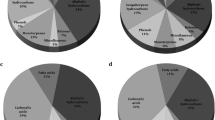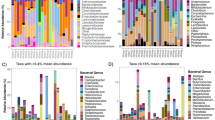Abstract
The chemical compositions of anal sac secretions of seven mustelid species were examined by thin-layer chromatography, gas chromatography, and mass spectrometry. The analyses showed great similarities between species belonging to the genusMustela, i.e.,M. erminea,M. nivalis,M. vison, andM. putorius, whereasMaries martes, Luira lutra, andMeles meles each showed a different pattern. Benzaldehyde was the predominant compound in the secretion ofM. martes. Sulfur-containing compounds (thietanes and dithiacyclopentanes) were characteristic for theMustela species. Some of the compounds were species-specific and the relative amounts of the compounds in common varied between the species. The chemical results are in agreement with systematics at the generic level. Species-specific chemical composition makes exchange of information possible between coexisting mustelids. The presence of the sulfur-containing compounds in the small mustelids may be an effect of the defense function of the anal sac secretion.
Similar content being viewed by others
References
Anderson, E. 1970. Quaternary evolution of the genusMartes (Carnivora, Mustelidae).Ann. Zool. Fennica 130:1–132.
Brinck, C., Gerell, R., andOdham, G. 1978. Anal pouch secretion in minkMustela vison.Oikos 38:68–75.
Corbet, G.B. 1978. The mammals of the Palaearctic region: a taxonomic review. British Museum (Natural History), Cornell Univ. Press, London.
Crump, D.R. 1978. 2-propylthietane. The major malodorous substance from the anal gland of the stoat (Mustela erminea).Tetrahedron Letters 50:5233–5234.
Crump, D.R. 1980a. Thietanes and dithiolanes from the anal gland of the stoat (Mustela erminea).J. Chem. Ecol. 6:341–347.
Crump, D.R. 1980b. Anal gland secretion of the ferret. (Mustela putorius forma furo.)J. Chem. Ecol. 6:837–844.
Erlinge, S. 1972. Interspecific relations between otterLutra lutra and minkMustela vison in Sweden.Oikos 23:327–335.
Erlinge, S., Sandell, M., andBrinck, C. 1982. Scent marking and its territorial significance in stoat,Mustela erminea.Anim. Behav. 30:811–818.
Ewer, R.F. 1968. Ethology of mammals. Elek Sci. Press, London.
Ewer, R.F. 1973. The carnivores. The World Naturalist. Weidenfeld and Nicolson, London.
Fredga, K. 1967. Comparative chromosome studies of the family Mustelidae (Carnivora, Mammalia).Hereditas 57:295.
Fredga, K. 1977. Chromosomal changes in vertebrate evolution.Proc. R. Soc. Lond. B 199: 377–397.
Goethe, F. 1964. Das Verhalten der Musteliden. Handbuch der Zoologie, VIII, 10. Teil, Beitrag 19:1–80.
Gorman, M. L. 1980. Sweaty mongooses and other smelly carnivores.Symp. Zool. Soc. Lond. 45:87–105.
Gorman, M.L., Jenkins, D., andHarper, R.J. 1978. The anal scent sacs of the otter (Lutra lutra).J. Zool. 186:463–474.
Grafodatsky, A.S., Volobuev, V.T., Ternovsky, D.V., andRadzhab-Li, S.I. 1976. G-banding of the chromosomes in seven species of Mustelidae (carnivora).Zool. J. 55:1704–1709.
Grafodatsky, A.S., Ternovsky, D.V., Isaenko, A.A., andRadzhab-Li, S.I. 1977. Constitutive heterochromatin and DNA content in some mustelids (Mustelidae, Carnivora).Genetica 13:2123–2128.
Hall, E.R. 1951. American weasels.Univ. Kansas Publ, Mus. Nat. Hist. 4:1–466.
Imai, H.T., andCrozier, R.H. 1980. Quantitative analysis of directionality in mammalian caryotype evolution.Am. Nat. 116:537–569.
King, C.M., andMoors, P.J. 1979. On co-existence, foraging strategy and the biogeography of weasels and stoats (Mustela nivalis andM. erminea) in Britain.Oecologia 39:129–150.
KurtÉn, B. 1968. Pleistocene mammals of Europe. Weidenfeld and Nicolson, London.
Macdonald, D.W. 1980. Patterns of scent marking with urine and faeces amongst carnivore communities.Symp. Zool. Soc. Lond. 45:107–139.
Mandahl, N., andFredga, K. 1980. A comparative chromosome study by means of G-, C-, and NOR-bandings of the weasel, the pygmy weasel and the stoat (Mustela, Carnivora, Mammalia).Hereditas 93:75–83.
Pocock, R.I. 1921. On the external characters and classification of the Mustelidae.Proc. Zool. Soc. Lond. 1921:803–837.
Pohl, L. 1910. Wieselstudien.Zool. Beobacht. 51:234–241.
Powell, R.A. 1979. Mustelid spacing patterns: variations on a theme byMustela.Z. Tierpsychol. 50:153–165.
Romer, A.S. 1966. Vertebrate Paleontology. Chicago Univ. Press, Chicago.
Schildknecht, H., Wilz, I., Enzmann, F., Grund, N., andZiegler, M. 1976. Über das Mustelan, den Analdrüsenstinkstoff des Nerzes (Mustela vison) und Iltisses (Mustela putorius).Angew. Chem. 88:228.
Simms, D.A. 1979. North American weasels: resource utilization and distribution.Can. J. Zool. 57:504–520.
Sokolov, I.I. 1968. Origin and systematic position of the Mustelidae family and the major trends of its evolution.Byull. Mosk. Obshch. Ispyt. Prir. Otdel. Biol. 73:5–16.
Sokolov, V.E., Chikildin, E.P., andZinkewitch, E. 1975. Free volatile aliphatic acids in the secretion of the anal gland of American mink (Mustela vison).Dokl. Acad. Nauk SSSR 220(1): 220–222.
Sokolov, V.E., Albone, E.S., Flood, P.F., Heap, P.F., Kagan, M.Z., Vasilieva, V.S., RozNov, V.V., andZinkevich, E.P. 1980. Secretion and secretory tissues of the anal sac of the mink,Mustela vison. Chemical and histological studies.J. Chem. Ecol. 6:805–825.
Stubbe, M. 1970. Zur Evolution der analen Markierungsorgane bei Musteliden.Biol. Zbl. 89:213–223.
Author information
Authors and Affiliations
Rights and permissions
About this article
Cite this article
Brinck, C., Erlinge, S. & Sandell, M. Anal sac secretion in mustelids a comparison. J Chem Ecol 9, 727–745 (1983). https://doi.org/10.1007/BF00988779
Received:
Revised:
Issue Date:
DOI: https://doi.org/10.1007/BF00988779




